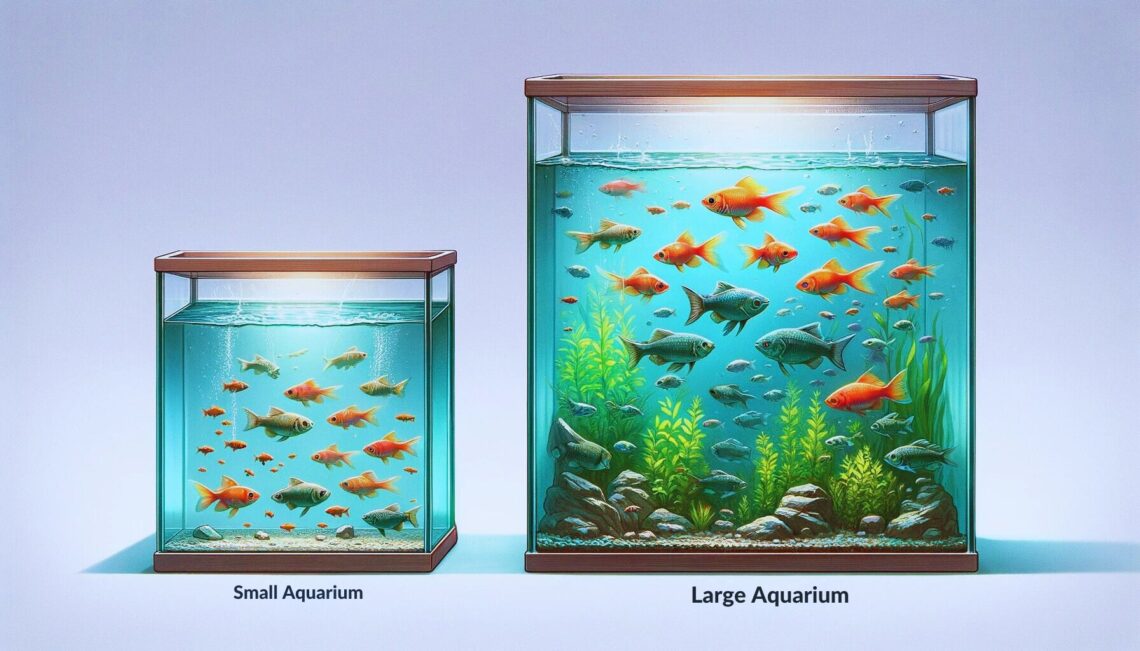Discover the essential factors in choosing the right aquarium size for your needs. Whether you’re a beginner or a seasoned fishkeeper, this guide will help you navigate through the various tank dimensions, and sizes, and how to use calculators to make the best decision for your aquatic pets. Understanding the right size is crucial for the health and happiness of your fish, whether in a freshwater or saltwater environment.
Key Takeaways:
- The importance of choosing the right aquarium size for specific fish needs.
- How different dimensions, materials, and shapes can impact the overall aquarium environment.
- Utilizing calculators and tools to make informed decisions about aquarium sizing.
- Common misconceptions about aquarium sizes and how to avoid them.
Why Aquarium Size Matters
I’ve learned through experience and extensive research the crucial role that aquarium size plays in the overall well-being of our aquatic friends. In this section, we’ll delve into why choosing the right aquarium size is vital for different types of fish, and how it impacts both fish health and aquarium maintenance.
The Importance of Selecting the Correct Aquarium Size
Understanding the Space Needs of Different Fish: Every type of fish has unique requirements when it comes to space. For instance, active swimmers like Danios need longer tanks, while territorial species like cichlids require more area to establish their domain. An undersized tank can lead to stress, which is detrimental to fish health.
Growth Expectations: Many fish enthusiasts start with a small aquarium, not realizing that some fish can grow significantly. It’s essential to anticipate the adult size of your fish to avoid overcrowding.
Schooling Fish Considerations: If you’re keen on keeping schooling fish, remember they thrive in groups. A larger tank allows you to keep an adequate number of these fish, ensuring their natural schooling behavior is supported.
How Aquarium Size Affects Fish Health
- Stress Reduction: In a spacious aquarium, fish have enough room to swim, hide, and establish territories, which reduces stress and related health issues.
- Water Quality Management: Larger tanks dilute toxins more effectively than smaller ones, leading to better water quality. This is especially crucial in saltwater setups, where water parameters can be more challenging to manage.
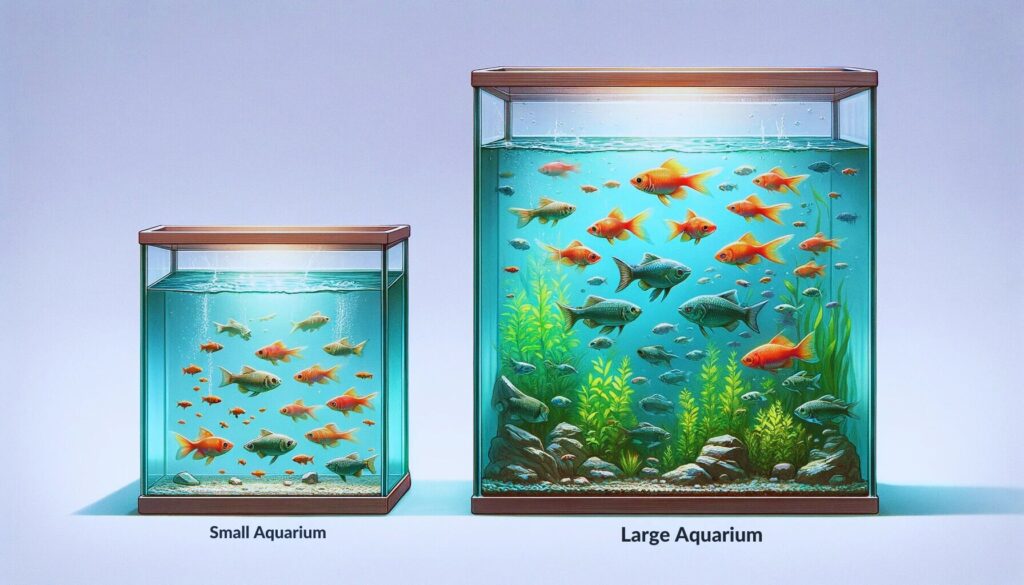
The Impact on Aquarium Maintenance
- Stability in Water Parameters: Larger aquariums tend to have more stable water parameters, making them more forgiving of minor mistakes or fluctuations. This stability is vital for both freshwater and saltwater environments.
- Maintenance Schedules: While larger tanks require more water for changes, they generally need less frequent maintenance. In smaller tanks, toxins can build up quickly, necessitating more regular cleaning and water testing.
Choosing the right aquarium size is not just about aesthetics or initial cost. It’s about providing a healthy and stable environment for your fish. Whether you have a single species or a community tank, a freshwater or saltwater setup, the size of your aquarium plays a pivotal role in the well-being of its inhabitants.
Understanding Different Aquarium Dimensions
Aquariums come in a variety of shapes and sizes, each offering unique benefits and challenges. Let’s explore common aquarium dimensions and how they cater to different fish species. Additionally, we’ll compare rectangular, bow-front, and hexagon tank shapes to help you make an informed decision when setting up your aquarium.
Common Aquarium Dimensions and Suitability for Fish Species
Small Tanks (5-10 gallons): Ideal for bettas, small schooling fish like neon tetras, or shrimp. They are perfect for limited spaces but require more frequent maintenance.
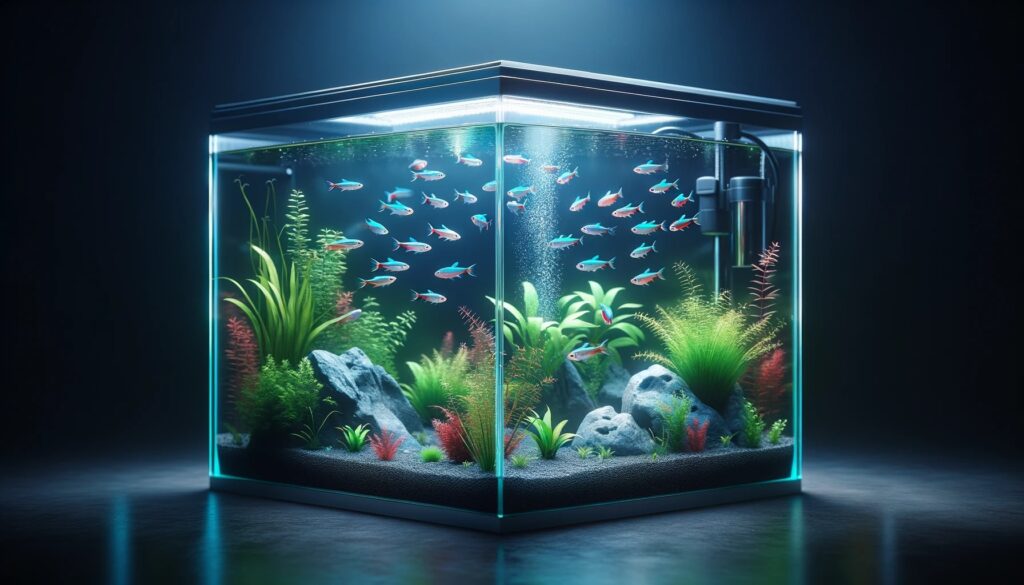
Medium Tanks (20-40 gallons): These tanks are versatile and suitable for a variety of freshwater and saltwater fish. They can accommodate small schools of fish and provide room for more elaborate aquascaping.
Large Tanks (50-100+ gallons): Suited for larger species, mixed communities, or those desiring sophisticated ecosystems. These tanks offer ample space for fish to exhibit natural behaviors and for stable water conditions.
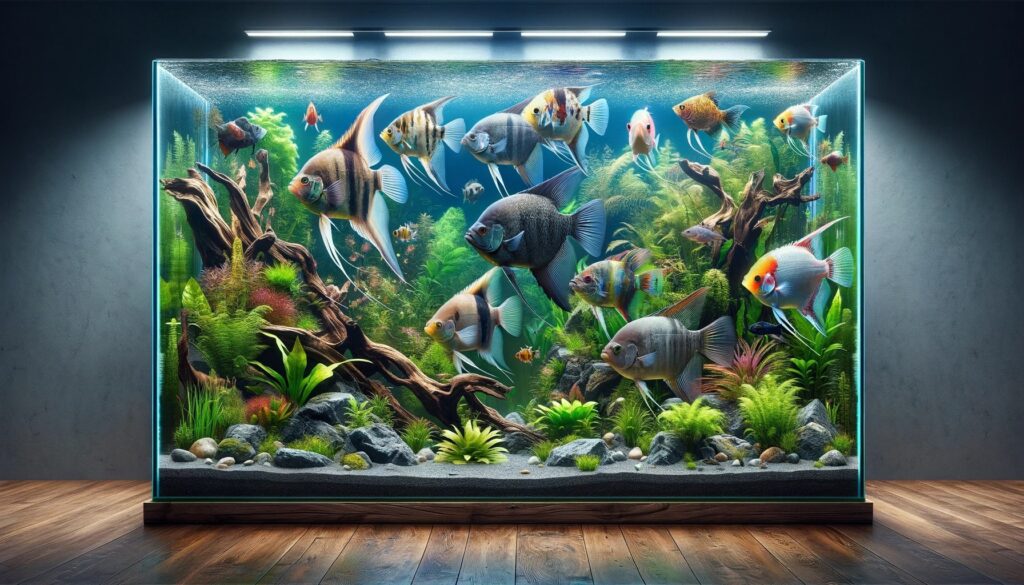
Comparing Aquarium Shapes
Rectangular Tanks
Pros:
- Efficient space utilization and easy to place in home settings.
- Offers the greatest surface area for gas exchange, beneficial for fish health.
- Simplifies lighting and filtration setups.
Cons:
- The common design may lack visual uniqueness.
Bow-Front Tanks
Pros:
- Aesthetically pleasing with a curved front glass offering a unique viewing experience.
- Can create a sense of larger space for fish due to the curved front.
Cons:
- More challenging to clean due to the curved glass.
- Can cause distortions in viewing angles.
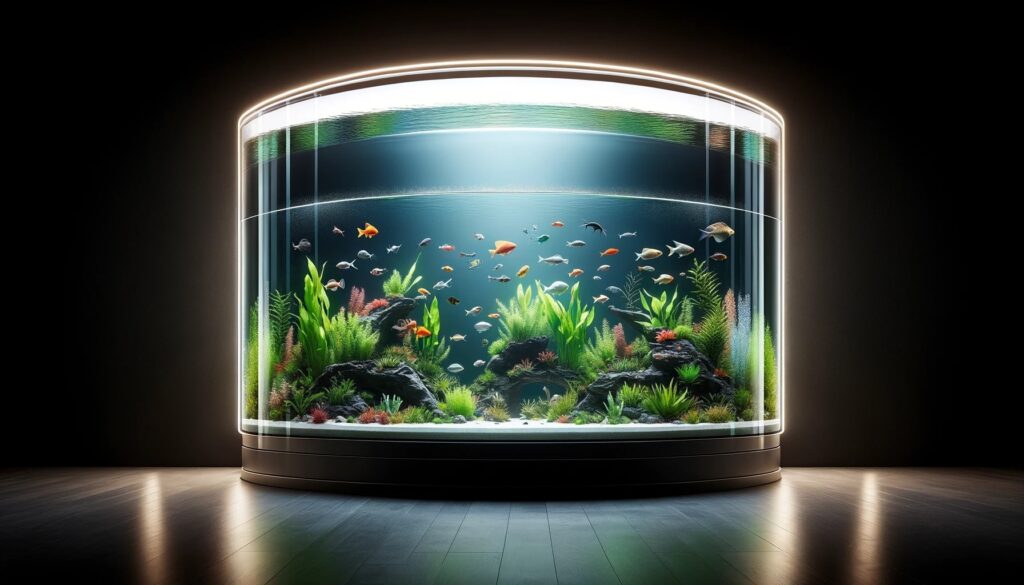
Hexagon Tanks
Pros:
- The unique shape adds a decorative element.
- Good for corner placements in a room.
Cons:
- Limited swim space for fish, especially larger or active species.
- Reduced surface area for gas exchange.
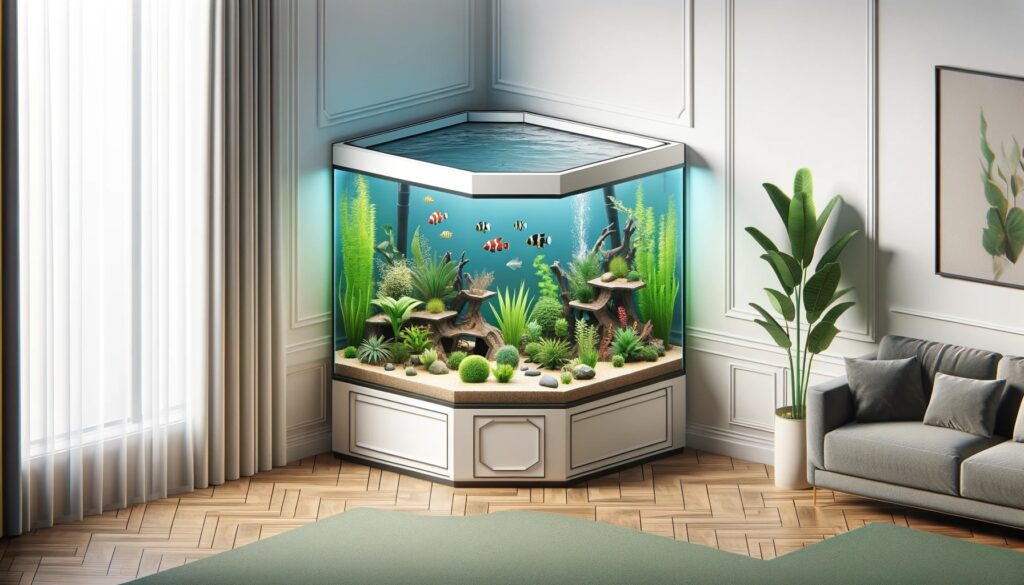
Understanding aquarium dimensions and tank shapes is crucial for creating a suitable and enjoyable environment for your fish. While rectangular tanks are the most versatile, bow-front and hexagon tanks offer unique aesthetic appeals. Always consider the needs of your specific fish species when choosing your tank.
Calculating Aquarium Volume
How to calculate the volume of water an aquarium can hold is essential. It’s not just about the numbers; it’s about ensuring the well-being of our friends. We’ll dive into the specifics of calculating aquarium volume, differentiating between gallons and liters, and understanding why these measurements matter.
Step-by-Step Guide to Calculating Aquarium Volume
Measure the Dimensions: Start by measuring the length, width, and height of your aquarium in inches. Ensure accuracy as even small errors can lead to significant miscalculations.
Basic Formula for Volume: The formula for calculating the volume in gallons is Length x Width x Height (in inches) / 231. This is because one gallon of water occupies 231 cubic inches.
Example Calculation: For an aquarium measuring 30 inches in length, 12 inches in width, and 18 inches in height, the volume would be (30 times 12 times 18) / 231, which equals approximately 33.5 gallons.
Convert to Liters if Necessary: To convert gallons to liters, multiply the volume in gallons by 3.785. This is important for fishkeepers who use metric measurements.
Continuing the Example: 33.5 gallons x 3.785 = ~126.7 liters.
Gallons vs. Liters: Understanding the Implications
Measurement Preferences: In the U.S., gallons are the standard unit for measuring aquarium volume, while most other countries use liters.
Impact on Fish Health and Maintenance: The volume of your aquarium affects everything from the number of fish you can keep to the type and frequency of maintenance required. Using the correct unit of measurement ensures proper care and management.
Importance in Treatment and Dosage: When treating water with conditioners or medications, dosages are often specified per gallon or liter. Accurate volume calculations ensure effective and safe treatment.
Understanding Product Specifications: Aquarium equipment like filters and heaters often have specifications based on the volume they can efficiently serve. Knowing your aquarium’s volume in both gallons and liters can aid in selecting the right equipment.
For more insights on selecting suitable equipment for your aquarium, consider exploring our comprehensive guides on aquarium filters and heaters.
Standard vs Custom Tank Sizes
In the world of fishkeeping, choosing the right tank size is as crucial as selecting the fish themselves. While standard aquarium sizes cater to a broad range of needs, sometimes a custom tank becomes necessary. Let’s explore the nuances of both options, helping you make an informed decision for your aquatic haven.
Understanding Standard Aquarium Sizes
Standard aquarium sizes range from petite nano tanks, often under 10 gallons, suitable for small fish or shrimp, to large aquarium sizes that can hold hundreds of gallons. Here are some common dimensions:
- Nano Tanks: Typically 2.5 to 10 gallons, ideal for desktops or small spaces.
- Medium Tanks: Ranging from 20 to 40 gallons, these are versatile for a variety of fish species.
- Large Tanks: 55 gallons and upwards, suitable for larger fish communities or ambitious aquascaping projects.
When to Consider Custom Tank Sizes
There are scenarios where a custom tank becomes more than a luxury:
- Specific Space Requirements: If you have an unconventional space, a custom tank can be built to fit perfectly.
- Unique Aquascaping Needs: For enthusiasts looking to create a specific underwater landscape, custom dimensions can provide the necessary canvas.
- Rare or Large Fish Species: Some fish, due to their size or behavior, require specially designed habitats.
Benefits and Drawbacks of Custom-Sized Tanks
Benefits
- Tailored Fit: Custom tanks can be designed to fit specific spaces and aesthetic preferences.
- Flexibility: You have more control over features like depth, length, and height, enabling unique aquascaping and fishkeeping experiences.
- Accommodation of Special Needs: They can be built to cater to the requirements of rare or large fish species that standard tanks can’t accommodate.
Drawbacks
- Cost: Custom tanks are typically more expensive than standard ones.
- Maintenance Challenges: Unusual shapes or sizes might complicate cleaning and maintenance.
- Equipment Compatibility: Finding equipment like lids, lights, or filters for non-standard sizes can be challenging.
For more information on how to select the right equipment for your aquarium, whether standard or custom, check out our equipment guide.
When it comes to choosing between standard and custom tank sizes, it boils down to your specific needs, the types of fish you plan to keep, and the space available. While standard tanks offer convenience and ease, custom tanks provide a unique opportunity to tailor your aquatic environment precisely to your vision. Whether you’re setting up a tiny nano tank or planning a large aquarium, understanding these differences will guide you toward making the best choice for your underwater world.
Fish Tank Shape and Its Impact
We often focus on size and volume, but the shape of the fish tank is equally crucial. The shape not only influences the aesthetics of your setup but also significantly impacts the behavior and health of your fish. Let’s dive into how different aquarium shapes affect both fish behavior and aquarium aesthetics, and weigh the pros and cons of popular shapes like rectangular, cube, and bow front tanks.
Influence of Tank Shape on Fish and Aesthetics
- Fish Behavior: Different shapes can affect how fish swim and interact. Longer tanks facilitate horizontal swimming, while taller tanks may limit this natural behavior.
- Aquascaping Possibilities: The shape of the tank can inspire unique aquascaping themes. A tall tank might lend itself to a dramatic vertical arrangement, while a long rectangular tank offers a panoramic view.
- Space Utilization: Some shapes are more space-efficient than others. For example, a cube tank might fit better in a corner but offer less swimming length for the fish.
Pros and Cons of Different Aquarium Shapes
Rectangular Fish Tanks
Pros:
- Provides ample horizontal swimming space, which is beneficial for many fish species.
- Easier to light evenly, ensuring good plant growth in planted tanks.
- The standard shape makes finding compatible equipment and decorations easier.
Cons:
- May require more space in a room due to their length.
- The standard look might not be as visually striking as other shapes.
Cube Tanks
Pros:
- Compact and space-saving, ideal for smaller spaces or desktops
- Offers equal viewing from all sides, creating a striking display
- Suitable for creating miniature ecosystems or nano tanks.
Cons:
- Limited horizontal swimming space, not ideal for active swimmers
- Can be challenging to create a natural flow with water movement and filtration
Bow Front Tanks
Pros:
- The curved front offers a unique and visually appealing view.
- Provides a sense of depth and space, enhancing the aesthetic appeal.
- Suitable for both freshwater and marine setups.
Cons:
- Distortion due to the curved glass can affect the view and fish observation.
- Can be more challenging to clean due to the curved front.
Choosing the right aquarium shape is not just about the look; it’s about creating an environment that suits both your fish’s natural behaviors and your aesthetic preferences. Whether it’s a traditional rectangular tank, a space-efficient cube, or an eye-catching bow front, each shape offers unique opportunities and challenges. As you plan your aquarium, consider these factors to ensure that your underwater world is not only beautiful but also a healthy habitat for its inhabitants.
Material Choices: Glass vs Acrylic Aquariums
When choosing an aquarium, the material is a significant factor to consider. Both glass aquariums and acrylic aquariums have their unique characteristics, influencing everything from installation to long-term maintenance. Let’s compare these two materials in terms of weight, durability, clarity, thickness, and scratch resistance.
Glass Aquariums
- Weight: Glass tanks are generally heavier than acrylic, which can be a factor in large setups or when placing an aquarium on surfaces with limited weight capacity.
- Durability: Glass is less likely to warp over time and maintains its shape well. However, it can shatter upon impact, which is a consideration in high-traffic areas.
- Clarity: Glass maintains clarity over the long term, resisting yellowing or clouding that can sometimes occur with acrylic.
- Thickness: The thickness of glass needed increases with the size of the aquarium to withstand the pressure of the water.
- Scratch Resistance: Glass is more resistant to scratches compared to acrylic. This makes it a good choice for households with pets or small children.
Acrylic Aquariums
- Weight: Acrylic tanks are significantly lighter than glass, making them easier to transport and suitable for locations where weight is a concern.
- Durability: While acrylic is less likely to break upon impact, it can warp over time, especially in larger sizes or under intense lighting.
- Clarity: Acrylic allows more light to pass through, providing a brighter display. However, it can yellow over time, especially under high exposure to UV light.
- Thickness: Acrylic tanks can be made thinner than glass tanks for the same volume, as acrylic has a higher resistance to water pressure.
- Scratch Resistance: Acrylic is more prone to scratching. However, minor scratches can be buffed out, a process not possible with glass.
Selecting between a glass aquarium and an acrylic aquarium depends on various factors like the desired size, placement, and the level of maintenance you’re comfortable with. Glass offers durability and scratch resistance, making it a reliable choice for many. On the other hand, acrylic stands out for its lightness and moldability, offering more versatility in shape and size. Understanding these differences will help you make a choice that not only enhances the beauty of your aquatic setup but also ensures its longevity and ease of maintenance.
Factors Affecting Aquarium Placement
Choosing the perfect spot for an aquarium involves more than just finding a space that looks good. Placing an aquarium in your home or office requires careful consideration of factors like weight, space, and aesthetics. Here’s what you need to know about selecting the ideal location for your aquatic setup.
Weight Considerations and Aquarium Stands
- Understanding the Weight of the Aquarium: The combined weight of the tank, water, substrate, and decorations can be substantial. For example, a 50-gallon tank can easily weigh over 400 pounds when filled.
- Choosing the Right Aquarium Stand: The stand must be capable of consistently holding the weight of the aquarium. It should be designed specifically for aquariums, as regular furniture may not have the required strength.
- Floor Strength: Especially in older homes or upper-floor apartments, it’s crucial to ensure that the floor can support the weight of a full aquarium.
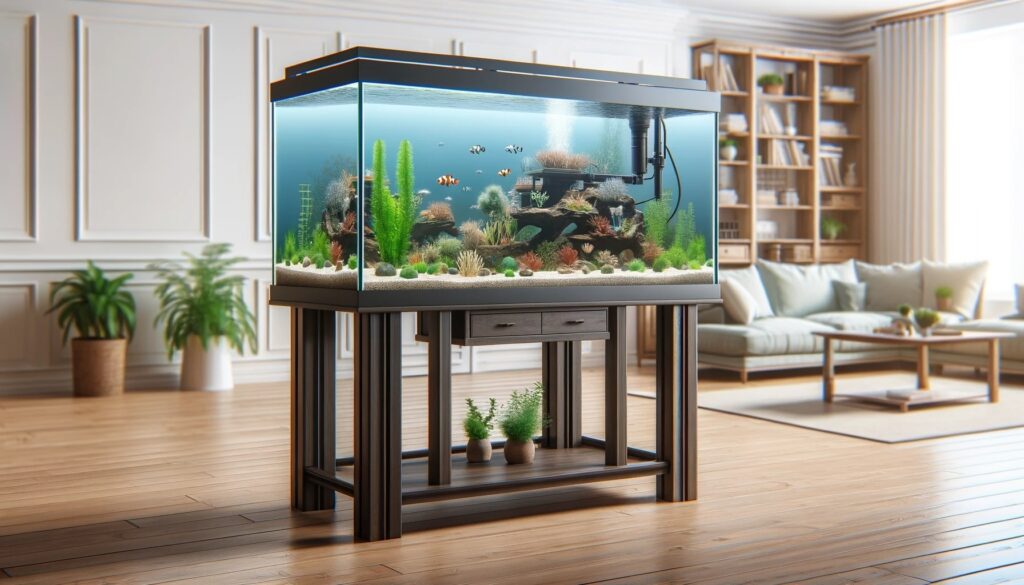
Space Requirements and Aesthetic Placement
- Sufficient Space for Maintenance: Ensure there’s enough room around the aquarium for routine maintenance tasks, like water changes and filter access.
- Viewing and Enjoyment: The location should allow for comfortable viewing. A common placement is in a living area where it can be enjoyed by everyone.
- Avoiding Direct Sunlight and High Traffic Areas: Direct sunlight can cause excessive algae growth, and high-traffic areas increase the risk of accidental damage.
- Integration with Room Aesthetics: Consider how the aquarium will complement the room’s design. A well-placed aquarium can be a stunning focal point in a space.
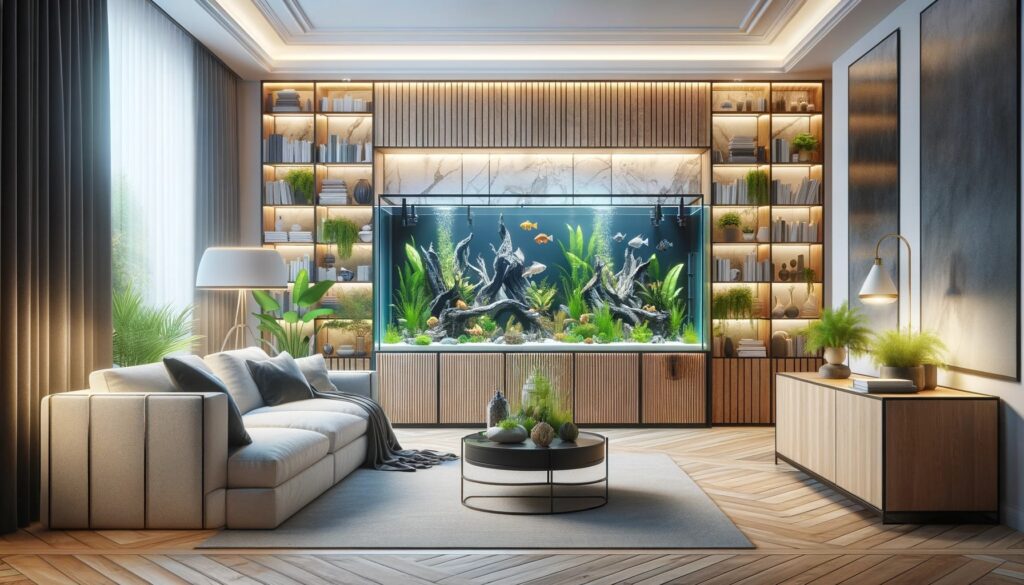
When it comes to placing an aquarium, the decisions you make can have a significant impact on both the health of your aquatic ecosystem and the enjoyment it brings. Weight is a critical factor, necessitating a robust aquarium stand and a supportive location. Space considerations ensure that your tank is both functional for maintenance and aesthetically pleasing. By thoughtfully addressing these factors, you can ensure that your aquarium is not only a beautiful addition to your space but also a sustainable habitat for your aquatic pets.
Calculators and Tools for Choosing the Right Aquarium
In the digital age, we have a plethora of tools at our fingertips to make fishkeeping more accessible and accurate. One such tool is the online calculator, specifically designed for calculating the volume and dimensions of aquariums. These calculators are invaluable for ensuring you choose the right size tank for your needs and the specific types of fish you wish to keep.
Online Fish Tank Size Calculators
- https://www.firsttankguide.net/calculator.php
- https://aquacadabra.com/pages/fish-tank-volume-calculator
- https://www.omnicalculator.com/other/aquarium-volume
Using Online Calculators for Tank Size and Dimensions
- Determining Tank Volume: Enter the length, width, and height of a prospective tank into a calculator to get the exact volume. This helps in understanding if the tank is suitable for your space and the number of fish it can hold.
- Custom Tank Dimensions: If you’re considering a custom-built aquarium, calculators can help you experiment with different dimensions to see how they impact the volume.
Calculators for Specific Fish Types
- Species-Specific Requirements: Some calculators take into account the needs of specific fish species. For instance, you can input the type of fish you’re interested in, and the calculator will suggest an appropriate tank size.
- Stocking Level Calculations: These tools can also help in determining how many fish of a particular species you can safely and ethically keep in a given tank size.
- Built-in Recommendations: Advanced calculators might offer built-in guidelines, like the recommended number of plants or the amount of substrate needed based on the tank dimensions.
The use of online calculators has revolutionized the way we approach aquarium setups. By calculating the volume and considering tank dimensions, these tools help us make informed decisions, ensuring that our aquatic habitats are not only beautiful but also suitable for the specific needs of our fish. Whether you’re a beginner or an experienced aquarist, these calculators are an essential part of your toolkit, helping you create a thriving underwater world for your aquatic companions.
Tips for First-Time Fishkeepers
Embarking on the journey of fishkeeping can be both exciting and overwhelming for first-time aquarists. The key to a rewarding experience lies in careful planning and informed decision-making. Here are some essential tips to help beginners in choosing the right aquarium and get started on the right foot.
Choosing the Right Aquarium Size
- Start Small: For beginners, it’s often recommended to start with a smaller, manageable tank, around 20-30 gallons. This size is large enough to be stable but not so large as to be overwhelming.
- Consider Fish Types: Research the fish you’re interested in keeping. Some species thrive in smaller freshwater tanks, while others may require larger or saltwater environments.
- Space Availability: Assess the space where you plan to place the aquarium. Ensure it can support the weight and size of the full aquarium setup.
Importance of Planning and Research
- Understanding the Ecosystem: Learn about the nitrogen cycle and the importance of water quality in maintaining a healthy aquarium.
- Equipment Essentials: Familiarize yourself with essential equipment like filters, heaters, and lighting, and understand their roles in your aquarium.
- Regular Maintenance: Plan for regular maintenance, including water changes, filter cleaning, and monitoring water parameters.
- Budget Considerations: Be mindful of the ongoing costs associated with fishkeeping, including food, electricity, and potential vet bills.
- Join a Community: Consider joining online forums or local fishkeeping groups to gain insights and support from more experienced hobbyists. You may always join my Facebook group 🙂
Being a first-time fishkeeper is an adventure filled with learning and growth. By choosing the right aquarium, conducting thorough research, and planning accordingly, you can lay the foundation for a fulfilling and successful fishkeeping experience. Whether you decide on a freshwater or saltwater setup, remember that patience and continuous learning are your best tools in this rewarding hobby.
Common Misconceptions About Tank Size
In the fishkeeping community, there are numerous myths and misconceptions regarding aquarium size. From the suitability of small tanks to the challenges of maintaining a large aquarium, it’s crucial to separate fact from fiction. Let’s debunk some common myths and provide clarity on the “one inch per gallon” rule and other size-related misconceptions.
Myths About Small Tanks
- “Easier to Maintain” Myth: Many believe that small tanks are easier to maintain due to their size. In reality, smaller tanks can be more challenging as water parameters can change rapidly, requiring more frequent monitoring and adjustments.
- “Suitable for Any Fish” Myth: It’s a common misconception that any fish can be kept in a small tank as long as it fits. However, fish need much space to swim and thrive, and some species require larger environments irrespective of their size.
- “Lower Cost” Myth: While the initial cost might be lower, small tanks often require more equipment and maintenance in the long run, which can add up.
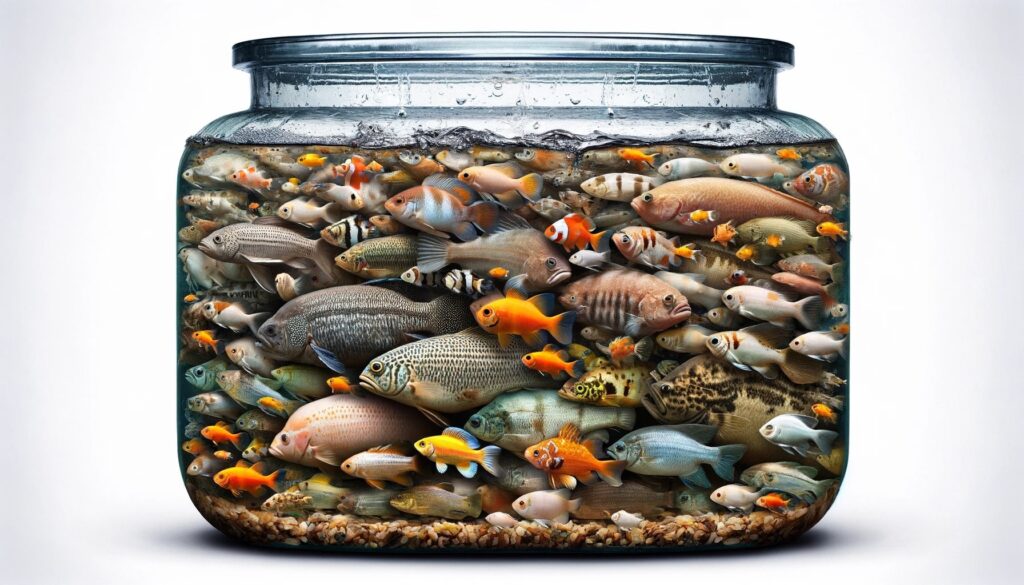
Myths About Large Tanks
- “Automatically Better” Myth: A larger tank isn’t inherently better. It needs to be the right size for the fish species you plan to keep, considering their space and environmental needs.
- “Difficult to Manage” Myth: Contrary to popular belief, large tanks can be easier to manage in terms of water quality stability. However, they do require more physical effort in terms of maintenance.
- “Extremely Heavy” Myth: While larger tanks are heavy, it’s important to remember that the weight (water weighs about 8.34 pounds per gallon) is distributed over a larger area, making it manageable with the right support.
Clarifying the “One Inch per Gallon” Rule
- Misconception: The “one inch of fish per gallon” rule is a widespread guideline but is overly simplistic. It does not take into account the shape and activity level of the fish, or the tank’s dimensions.
- Reality: Fish need room to swim and thrive, and their space requirements vary greatly. Factors like the fish’s adult size, behavior, and social needs are crucial in determining how much space is needed.
Dispelling these misconceptions about tank size is vital for responsible fishkeeping. Understanding that both small tanks and large aquariums have their own set of challenges and benefits is key. Additionally, moving beyond the “one inch per gallon” rule and considering the unique needs of your aquatic pets will ensure that you provide them with the space and environment they require to thrive.

